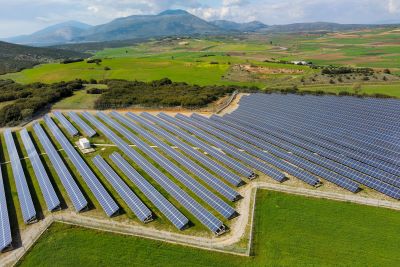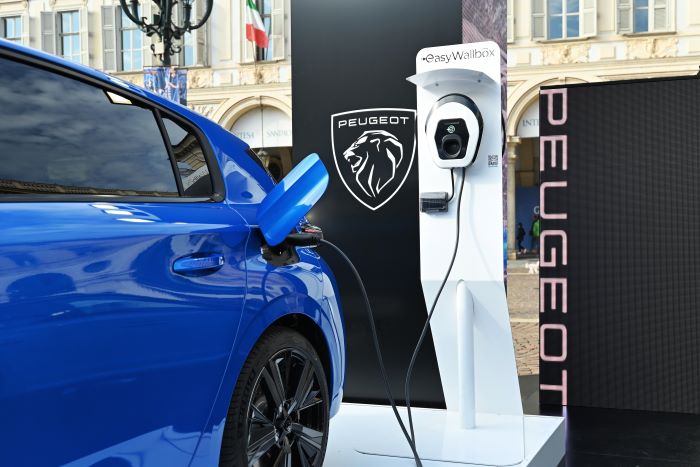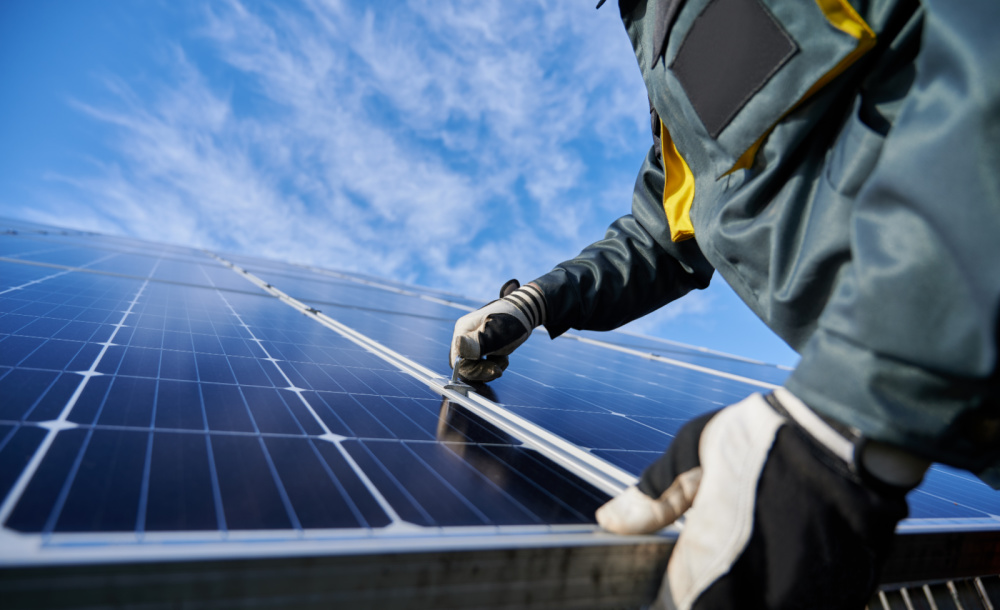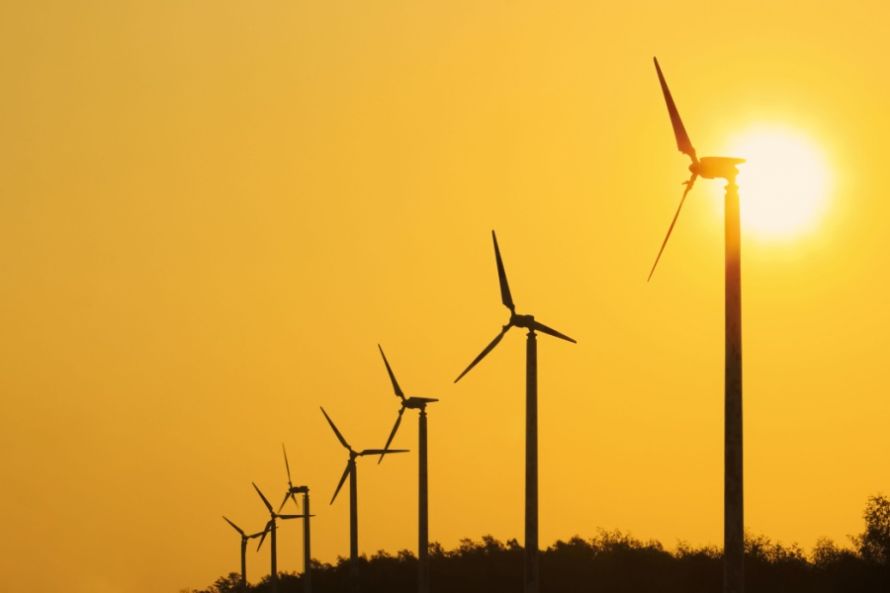The U.S. has set another quarterly record for solar module manufacturing capacity, hitting 9.3 gigawatts (GW) in the third quarter of 2024, according to a joint report released this week by the Solar Energy Industries Association (SEIA) and Wood Mackenzie.
The record was set as the solar sector sees strides in strengthening the U.S. solar manufacturing supply chain, overcoming obstacles associated with a global oversupply driven by China’s gigantic manufacturing capacity and policy uncertainty in the U.S. The growth also came as solar companies utilize tax incentives to reduce reliance on non-U.S. companies amid an ongoing push to lower emissions.
“Federal solar policies and increased private investments are strengthening our nation’s energy security and creating thousands of new job opportunities for American workers,” SEIA President and CEO Abigail Ross Hopper said in a news release. “The United States is stepping up to take market share from foreign competitors and making sure that the jobs and economic growth from solar are benefiting American communities.”

Another quarterly notable: U.S. solar silicon cell production resumed for the first time since 2019, according to the report. Suniva in November restarted commercial production of silicon-based components at its Norcross, Georgia, factory, according to media reports.
With five new or expanded factories in Alabama, Florida, Ohio and Texas, U.S. solar module manufacturing capacity grew to about 40 GW. That was up from only 7 GW before the introduction of domestic manufacturing and procurement tax credits in the Inflation Reduction Act.
For third-quarter 2024, the solar sector installed 8.6 GW of new electricity generation capacity, marking a 21% year-over-year increase and a third-quarter record. The utility-scale segment continued to dominate with 6.6 GW of new projects coming online.
Texas again led the nation in solar deployments with the addition of 2.4 GW of capacity in the third quarter, according to the report. Texas, which accounted for more than one-quarter of the new capacity that went online, was followed by Florida.
The report forecasts solar annual installation volumes of at least 43 GW through the end of the decade. Total U.S. solar will be enough to power over 71 million homes by 2029, according to the report.
“Our current outlook for the next five years has the U.S. solar industry growing 2% per year on average, reaching a cumulative total of nearly 450 GW by the end of 2029,” said Michelle Davis, head of solar research at Wood Mackenzie and lead author of the report. “Demand for solar remains robust, and annual installation forecasts would be higher if not for limitations the industry faces, including those related to interconnection, labor availability, supply constraints and policy.”
Here’s a roundup of some renewable energy news.
Bioenergy
Vision RNG Seals Landfill Gas Agreement in South Carolina
Vision RNG plans to transform Greenwood County South Carolina landfill gas into renewable natural gas (RNG) or power after sealing a long-term gas rights agreement with the county.
The Pennsylvania-based landfill gas and RNG developer said Dec. 2 the agreement to purchase raw landfill gas could last up to 25 years. Plans are to spend the next 12 months working with county and landfill personnel to optimize the existing gas collection and control system to determine the amount of gas available, Vision RNG said in a news release.
The evaluation will determine whether the landfill could support RNG production or a power project.
“As our portfolio of landfill gas projects continues to expand, we are making a real impact on reducing methane emissions, capturing that wasted greenhouse gas and putting it to good use,” Vision RNG CEO Bill Johnson said.
If the developer produces RNG, the gas will be used as transportation fuel and for other sustainable purchases across the U.S., the company said. If power is produced from the landfill gas, Vision RNG said it will be sold to the local grid operator.
“By capturing methane from our landfill and converting it into renewable energy, we are taking meaningful action that makes sense both environmentally and economically,” Greenwood County Council Chairman Chuck Moates said.
Energy storage
Portugal Plans to Hold Delayed Lithium Tender in 2025
Portugal’s government said Dec. 3 it plans to launch a long-delayed tender of lithium prospecting licenses in 2025 as it seeks to make the country a top European supplier of critical metals for the green transition.
The center-right government, which took over in April, said that the international tender for lithium prospecting will target six areas in the north and center of the country.
The previous socialist administration initially planned an auction in 2018, but concerns about the environmental and social impact of lithium mining have led to multiple delays to the auction.
Environment Minister Maria da Graca Carvalho said that the tender is part of Portugal's plans to meet Europe’s goals to ensure greater security and reduce dependence on imports of critical materials from countries such as China.
“Our intention is to move forward with the tender in 2025,” she told journalists, adding that the government wants to speed up the licensing processes for projects, "but will be demanding in assessing the environmental impacts."
With some 60,000 tonnes of known reserves, Portugal is Europe's biggest lithium producer but its miners sell almost exclusively to the ceramics industry and are only now preparing to produce the higher-grade lithium for use in electric vehicles.
Portugal’s environmental agency APA (Agência Portuguesa do Ambiente) has already given its initial approval to lithium extraction at the Barroso mine, owned by London-based company Savannah Resources, and at the Montalegre mine of the local firm Lusorecursos, both in the north of the country.
The start of exploration in both mines is scheduled for 2027 as they still need licensing authorizations for the concrete projects.
US Plans $7.5B Loan for Stellantis, Samsung JV for Battery Factories

A joint venture (JV) between carmaker Stellantis and Samsung could get a more than $7.5-billion boost after the U.S. Department of Energy (DOE) said on Dec. 2 it plans to help finance the build-out of battery manufacturing facilities.
However, the conditional loan commitment—comprised of $6.85 billion in principal and $688 million in capitalized interest—must be finalized. To secure the loan, StarPlus must meet certain technical, legal, environmental and financial conditions. The company also must develop and implement a community benefits plan, engaging with the community and labor stakeholders to create “good-paying jobs and improve the well-being of the local community and workers,” according to the LPO.
If given the final go-ahead, the StarPlus Energy JV will use the financing for up to two lithium-ion battery cell and module manufacturing plants in Kokomo, Indiana.
The project is expected to produce about 67 gigawatt hours (GWh) of batteries, which the DOE’s Loan Programs Office (LPO) said is enough to supply about 670,000 vehicles annually when it reaches full capacity.
The JV has plans for two gigafactories in Kokomo. The first is expected to open in 2025 with an annual production capacity of 33 GWh. Production at the second gigafactory, announced in October 2023, is expected to begin in early 2027 with an annual capacity of 34 GWh.
The battery cells and modules produced at the new facilities will be sold to Stellantis for use in EV models that will be sold in North America. Stellantis brands include Chrysler, Dodge, Fiat, Jeep, Maserati and Ram, among others.
Geothermal
Chord Energy Taps Gradient Geothermal Tech for Power
Gradient Geothermal has used its technology to harness waste heat to help power Chord Energy’s oil and gas facility in the Williston Basin.
The first-of-its-kind deployment for the geothermal company in North Dakota involved removing heat from produced fluids to create electricity, Gradient said Dec. 4.
The Colorado-based technology company’s fit-for-purpose Organic Rankin Cycle equipment is used to cool produced fluids and generate emissions-free geothermal electricity. The electricity generated can be used on the pad or net-metered to the grid, according to the company’s website.
“Properly capturing highly sustainable geothermal energy already present at active energy production projects presents a new avenue of opportunity for government agencies and leading commercial entities alike,” said Gradient Geothermal CEO Benjamin Burke, “and we could not be more excited to work with Chord to help deploy Gradient’s innovative technology within this expansive, forward-thinking initiative.”
The project was partially funded by the North Dakota Industrial Commission’s Clean Sustainable Energy Authority grant program. Enerplus Corp., which merged with Chord earlier this year, received more than $1 million in funding for geothermal power generation for oil and gas production.
RELATED
Quaise, Partners to Retrofit Fossil Fuel Plant for Deep Geothermal
Hydrogen
Ecopetrol to Build Green Hydrogen Plant at Cartagena Refinery
Colombia’s majority state-owned energy company Ecopetrol plans to build a new green hydrogen plant at its refinery in the Caribbean city of Cartagena for some $28.5 million, it said in a statement Dec. 2.
The plant will produce 800 tonnes of green hydrogen a year, making it Latin America’s biggest, Ecopetrol said in the statement.
Colombia’s President Gustavo Petro has made weaning the Andean country off of fossil fuels a major goal of his administration and Ecopetrol—the country’s biggest company—has previously announced plans to take part in an auction for planned offshore wind projects.
“Ecopetrol has entered the modern era of producing clean fuels,” the company’s CEO Ricardo Roa said in the statement.
Production of low-emission hydrogen could contribute between $400 million and $485 million on average per year by 2040 to the company’s EBITDA, Ecopetrol added in the statement.
Solar
Meta Taps Invenergy for More Solar Energy

Chicago-based Invenergy landed four contracts with Meta Platforms to provide 760 megawatts (MW) of energy, lifting its total environmental attribute purchase agreements with the tech company to more than 1 GW.
The contracts are for electricity from four solar facilities that will be connected to the power grid between 2024 and 2027, the company said Dec. 5. The projects are 150-MW Hardin II in Ohio; the 150-MW Delilah II Solar in Texas; the 110-MW Tip Top Solar in New Mexico; and the 350-MW Chalk Bluff Solar in Arkansas.
“Surpassing the 1 GW milestone in renewable energy procurement from Invenergy is a testament to Meta’s commitment to matching our growing power needs with clean energy,” said Urvi Parekh, Meta’s head of global energy. “We’re grateful for Invenergy’s long-term collaboration. These projects will help us continue our commitment to support all of our operations with 100% clean energy.”
Meta will receive clean energy credits for bringing new generation capacity online.
Wind
JDR Cables Wins Contract for Dominion Energy’s Offshore Wind Project
Subsea cable and umbilical supplier JDR Cables has been selected by DEME Offshore to provide cable installation and commissioning services for the Dominion Energy-operated, 2.6-GW Coastal Virginia Offshore Wind (CVOW) project.
In a Dec. 3 news release, JDR Cables said its work scope covers the wind farm’s 176 wind turbines and three offshore substations. The contract includes pull-in, termination, testing and commissioning of all the 66-kV subsea interarray cables. The work is scheduled to begin in 2025 and continue into 2026, JDR said.
“During installation, as part of the pull in scope, JDR teams will securely winch and pull the cables from the seabed to the turbines. Afterwards, they will fit electrical connectors and perform termination testing to ensure secure connections,” the company said in news release. “For testing and commissioning, high voltage tests and final inspections will be conducted to confirm the integrity of the cables, ensuring they are ready for reliable power transmission.”
CVOW is expected to be the largest offshore wind farm in the U.S. when it becomes fully operational in 2026. Located off Virginia Beach, the wind project is expected to provide enough power for about 660,000 homes.
Apex Locks In Financing For North Carolina Wind Farm

Apex Clean Energy has secured financing for the 189-MW Timbermill Wind facility, the second wind farm in North Carolina, the company said Dec. 5.
Construction financing was provided by coordinating lead arrangers Helaba, BNP Paribas, SMBC and Societe Generale, while Goldman Sachs made a tax equity investment, Apex said in a news release.
“The successful financing of Timbermill Wind represents a pivotal milestone in North Carolina’s energy transition and underscores the growing demand for wind power in markets across the country,” said Apex Clean Energy CEO Ken Young. “Amid a complex permitting landscape, Timbermill was enabled by strong community support, visionary partnerships and deep development expertise—and today, the project is already delivering substantial local economic benefits while poised to meet the rising demand for carbon-free power.”
Timbermill Wind is the first wind project approved by North Carolina’s Department of Environmental Quality since state lawmakers passed siting legislation in 2013, according to the news release. Weyerhaeuser is the anchor landowner for the project.
Construction is underway, and commercial operations are expected to begin by year-end 2024. In 2023, Google signed a power purchase agreement with Apex for energy from the wind farm.
Shell Slows Offshore Wind Spending
Shell is stepping back from new offshore wind investments and is splitting its power division following an extensive review of the business that was once seen as a key driver of the company’s energy transition strategy.
The changes are part of a company-wide review launched in 2023 aimed at reducing costs as CEO Wael Sawan focuses on activities with the highest returns. In many cases that has meant reducing spending on low-carbon and renewable businesses and increasing the focus on oil, gas and biofuels.
“While we will not lead new offshore wind developments, we remain interested in offtakes where commercial terms are acceptable and are cautiously open to equity positions, if there is a compelling investment case,” a company spokesperson said in a statement.
Shell and other major energy companies have in the past touted offshore wind as a key market they can invest in as part of the world’s energy transition, drawing on their decades-long experience in offshore oil and gas production.
But the sector has been hit in recent years by soaring costs, supply chain issues and rising interest rates, leading companies to review investments as profit margins narrowed.
Shell’s retreat mirrors moves by BP and Equinor that have slowed investments in renewables and low-carbon business as they face investor pressure to boost returns and maintain large shareholder payouts. Their change of direction reflects two major developments—the energy shock from Russia’s invasion of Ukraine and a drop-in profitability for many renewable projects.
Shell will continue to develop offshore wind projects already underway, it said. The company in recent months has retreated from several offshore wind projects, including in South Korea and the U.S.
The changes were announced in an internal presentation by Shell Energy head Greg Joiner on Dec. 4, two company sources said.
Hart Energy Staff and Reuters contributed to this report.
Recommended Reading
E&P Highlights: Jan. 21, 2025
2025-01-21 - Here’s a roundup of the latest E&P headlines, with Flowserve getting a contract from ADNOC and a couple of offshore oil and gas discoveries.
E&P Highlights: Feb. 24, 2025
2025-02-24 - Here’s a roundup of the latest E&P headlines, from a sale of assets in the Gulf of Mexico to new production in the Bohai Sea.
E&P Highlights: March 24, 2025
2025-03-24 - Here’s a roundup of the latest E&P headlines, from an oil find in western Hungary to new gas exploration licenses offshore Israel.
CNOOC Makes Oil, Gas Discovery in Beibu Gulf Basin
2025-03-06 - CNOOC Ltd. said test results showed the well produces 13.2 MMcf/d and 800 bbl/d.
E&P Highlights: Feb. 18, 2025
2025-02-18 - Here’s a roundup of the latest E&P headlines, from new activity in the Búzios field offshore Brazil to new production in the Mediterranean.
Comments
Add new comment
This conversation is moderated according to Hart Energy community rules. Please read the rules before joining the discussion. If you’re experiencing any technical problems, please contact our customer care team.





